
Zenith Energy intends to drill on the Tilapia licence in Congo Brazzaville in April while planning exploration drilling in Azerbaijan this year.
Combined with the issue of a variety of notes and the acquisition of Coro Energy’s Italian assets, announced in December, “it has been a busy start to the year” for the company, CEO Andrea Cattaneo said. Zenith launched a takeover bid for Anglo African Oil & Gas’ (AAOG) Congo unit at the end of 2019.
“We are actively seeking to enrich our portfolio with the acquisition of AAOG Congo which we believe has the potential to deliver transformational value via successful drilling activities in the Mengo and Djeno horizons. Recent progress has been very encouraging, and I look forward to updating shareholders further in due course,” Cattaneo said.
Zenith’s management visited Congo Brazzaville recently, where it is acquiring an 80% stake in AAOG Congo, which has a 56% stake in the Tilapia licence. The company also has an option to acquire the remaining interest.
Management held talks with local authorities on renewing the licence for a new 25 year term and presented its development plans to Société Nationale des Pétroles du Congo (SNPC). Zenith said talks had involved geological and technical plans for work in the Mengo and Djeno horizons.
SNPC owes $5.3 million to AAOG and Zenith intends to collect on this debt. The statement said it had been encourage in this regard. The Congolese government has pushed for the Mengo to be developed, with the Djeno seen as a longer term opportunity.
Two drilling rigs have been identified to start work, close to the licence. Zenith said both would be rigorously tested. One of the obstacles for AAOG was problems with its rig, which made drilling take much longer than planned.
The core focus for Zenith remains in Azerbaijan. The company is working on various investigations with the State Oil Company of Azerbaijan (SOCAR) and these should be finalised by mid-March.
Zenith is waiting for approval to drill the C-30 well in Azerbaijan and is planning isolation work in the C-37 hole, in order to enhance production from the Middle Eocene.
